Articles
Interpreting Environmental History through Material Culture
Abstract
In an exhibition called UnEarthing the Secret Life of Stuff: Americans and the Environment, the Strong Museum uses nineteenth- and twentieth-century domestic artifacts to introduce its audience to the subject of environmental history. The author, who served as principal researcher for the exhibit, discusses strategies for using material culture analysis to explore both the ideas about nature that everyday objects convey and the changing historical relationships between people and their surroundings that objects embody. Examples from the exhibit show how museum audiences can be enlisted in the effort to make environmental meanings from their material culture.
Résumé
Dans le cadre d'une exposition intitulée UnEarthing the Secret Life of Stuff: Americans and the Environment, le musée Strong fait appel à des articles ménagers des XIXe et XXe siècles pour introduire les gens à l'histoire environnementale. L'auteur, qui a été chercheur principal dans le cadre de l'exposition, décrit pourquoi l'analyse de la culture matérielle permet de découvrir comment ces objets courants reflètent ce qu'on pense de la nature et comment ils sont l'expression de l'évolution des liens historiques entre les gens et leur milieu. Des exemples tirés de l'exposition indiquent comment les visiteurs d'un musée peuvent cerner la signification environnementale de leur culture matérielle.
Museums and the Meaning of Material Culture
1 Museums stake out new territory when they ask novel, surprising, or unexpected questions about existing artifact collections. Objects collected for one specific purpose (or sometimes, for no specific purpose at all) can take on new life when reinterpreted in light of our changing perspectives on culture, society, and history. In this essay I reflect on the process of rediscovering the meaning of our material culture as it relates to the emerging field of environmental history. As a case study I examine some of the ways that the Strong Museum has used its collection of nineteenth-and twentieth-century domestic artifacts to introduce its audience to environmental history in an exhibit called UnEarthing the Secret Life of Stuff: Americans and the Environment.
2 An ever-increasing number of museums are committing themselves to the enterprise of "making" historical meaning in partnership with their public audiences. One essential strategy for doing so enlists museum visitors in a dialogue about the meaning of objects in museum collections. It explicitly surrenders part of the museum's imputed authority over interpretation, and attempts in return to capture and incorporate an element of the public's own reflective creative input. The notion that this type of reciprocity is possible rests on the belief that object meanings are not fixed, but instead change as society changes. It also rests on the idea that understanding the meaning of material culture necessarily involves the fullest possible exploration of its cultural and historical context, and must therefore transcend the once-dominant focus of material-culture study on date, maker, style, origin, function, and so on. New developments in the material culture field are leading the way towards this more supple and subtle understanding of what objects mean.1
3 The study of material culture begins with the assertion that we can ascertain the meaning of objects at several different levels. We believe that objects tell stories, or rather, that objects can be made to reveal stories — not just about their makers and users, but about complex historical ideas and relationships that exist within the cultures that created them. As physical evidence from the past, objects can both convey and embody historical information to be read, intuited, puzzled over, and argued about — in other words, subjected to the same kinds of critical questioning and testing by which we evaluate historical evidence from other sources. No matter what form it takes, historical evidence lies mute until we bring our interpretive skills to bear.2
Environmental History: A New Field of Inquiry
4 Over the past fifteen years, environmental history has established itself as an exciting and innovative new field for historical study. It explores the dynamic, reciprocal relationship between human beings and their surroundings. It analyzes and explicates "nature" as a phenomenon and a social construct, and traces the complicated history of changes in nature, in human ideas about nature, and in the relationship of those ideas to our behavior.3 Environmental historians conceive of nature's history as sometimes dependent on and sometimes independent of human influence, but acknowledge that over the past three hundred years, humans have developed an increasing capacity to effect long-term transformations in the environment.4
5 Fundamental transformations in both the forces and relations of human production and consumption in North America have taken place at least twice during the past three hundred years, with far-reaching natural consequences. The first transformation, during the seventeenth century, involved the creation along the eastern seaboard of an extensive agrarian society by European colonists and African slaves that displaced, often forcibly, the subsistence village society of indigenous native peoples. The second transformation, beginning by the end of the eighteenth century, saw the creation of an industrial society based on the rising dominance of intensive market economies in both agriculture and manufacturing. A third such transformation is currently under way, as producers and consumers in the region's advanced industrial nation-states forge increasingly complex economic connections with each other and with the developing nations in the emerging global economy as well.5
6 One useful way of exploring environmental history from the perspective of material culture is to ask what types of ideas everyday objects convey about nature and about the relationship between people and the environment. This is the most accessible level of object meaning as it relates to environmental history.
7 For example, no two objects connected nineteenth-century Americans more closely to the process of environmental transformation than the axe and the plough. But the power of these objects as symbols — as objects that convey meaning — goes far beyond their potential physical impact on the landscape. The axe and the plough stood for progress and civilization. An 1869 photograph of the Unitarian minister Edward Everett Hale and his son (Fig. 1) epitomizes this symbolism. Hale stands behind his son, placing a reassuring hand upon his shoulder. The son stands barefoot, trousers rolled almost to the knee, a seed apron draped over one shoulder, as he grasps the twin handles of a plough. With one hand he also holds the reins of his imaginary plough horse. Carefully positioned for visibility, a hand-axe hangs at the ready. Surrounded by these richly suggestive (and explicitly male) symbols of human relationships to nature, the son stares intently into the distance, concentrating on his mission as a tiller of the soil, a transformer of the landscape, a tamer of the wilderness, and an instrument of American destiny, urged on by his father's guiding hand. The meaning of the photograph — to both the subjects and the outside observer — relies on the power of the objects as universally recognized symbols of humankind's power to harness the environment.
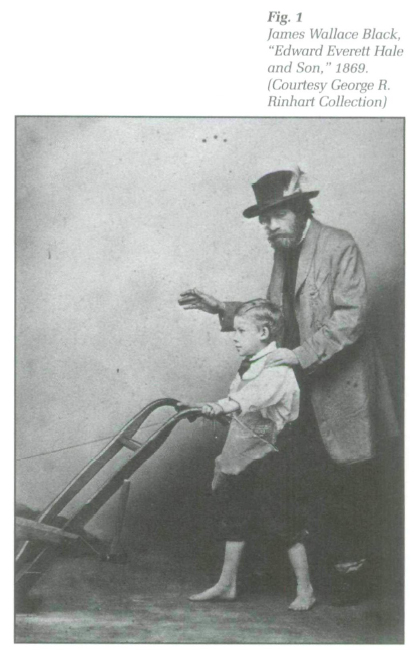 Display large image of Figure 1
Display large image of Figure 1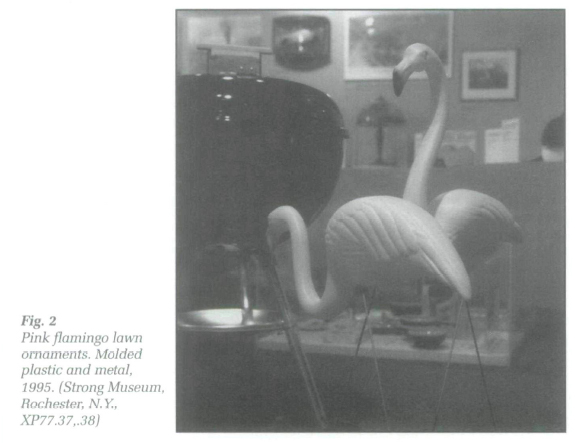 Display large image of Figure 2
Display large image of Figure 28 A more recent but equally compelling example of the way objects convey meaning about nature is found in the now ubiquitous plastic pink flamingo lawn ornament (Fig. 2). When pink flamingoes first appeared on suburban lawns in the 1950s, these plastic models of an exotic bird from Florida represented the homeowner's licence and wherewithal to reshape nature within the boundaries of a single house lot. Within a couple of decades, however, pink flamingoes had taken on new meanings — not just as symbols of lowbrow bad taste, but, more to the point, of ironic comment on our detachment from nature and our impulse to exercise control over it. These new meanings arose from Americans' changing ideas about environmental issues and from a growing awareness of the connections between our behavior and its environmental consequences. However construed, the plastic pink flamingo conveys powerful ideas about our changing relationship to nature.6
9 Thinking about some of the ways that material culture conveys ideas about nature and environment is a good place to begin a material exploration of environmental history, especially with a public audience that tends not to think in terms of objects as representing either ideas or meaning. But because environmental history is ultimately concerned with the relationships between people and their surroundings, it is important to probe deeper into object meaning. This involves exploring the relationships that objects embody — the patterns of lived experience to which they attest, and the specific historical events surrounding their "lives" as objects. Especially in the context of our commodity-intensive roles as consumers, the object meanings we negotiate with makers, advertisers, family, friends, and ourselves have important environmental implications.
10 One of the fundamental insights advanced in recent work on environmental history is that changing human modes of production have had critical (and potentially dire) implications for humanity's relationship with the environment.7 At the same time, the forces and relations that govern how we consume the massive quantities of goods that we produce and the wealth we extract directly from nature — that is, modes of consumption — exert an equally powerful influence over our relationship with the environment.8 Material culture analysis is ideally situated to help shed light on these complex relationships and transitions because objects constitute the fabric of connection between production and consumption, and because the history of both production and consumption is embedded in the everyday objects we encounter in our material lives. For a variety of important reasons, however, the meanings that surround material objects in our contemporary consumer culture tend to obscure the complex environmental histories that those objects embody. A brief digression will help clarify this assertion.
11 Anthropologist Grant McCracken has written at length about the creation of object meaning in our culture. According to McCracken, consumer goods play a crucial role as repositories for the cultural meanings that our society creates, thus providing a source of continuity in our rapidly changing cultural life. Consumption, for McCracken, is the activity that holds modern society together.9 Whereas critics of modern consumer culture find the practice of seeking meaning through goods repugnant, McCracken sees it as one of the principal ways that we preserve and "cultivat[e] hopes and ideals" — principally through the further expansion and satisfaction of our consumer appetites.10
12 However one may feel about the process McCracken describes, the beauty of his work is its explicit and convincing description of the ways that meaning passes back and forth among individuals, the goods they consume, and the culture in which they are produced. We seek meaning in, and therefore define ourselves, he argues, by the things we consume. The principal source of object meanings in modern consumer culture is, not surprisingly, the commercially constructed universe of advertising, fashion, and mass consumption that shapes the marketplace.11
13 A second discussion of the way that objects have become separated from meanings that reveal their environmental connections appears in the work of the cultural geographer Robert Sack. Sack agrees with McCracken that consumption shapes meaning in consumer culture, or in Sack's terms, "creates contexts" that place the individual consumer, rather than the object being consumed (or by extension, the environmental context in which the object belongs), at the center of the process.12 For Sack, however, this process is not the logical culmination of cultural history in a modern society, but rather an inherently irrational behavior that can take place only because its implications are so completely hidden from those who participate in it. In other words, in a society built around mass production and consumption, an artificially constructed barrier of cultural falsehood separates the behavior of individual consumers from its environmental consequences.
14 Contemporary consumer culture, according to Sack, has lost the external logic essential to acknowledging the consequences (including the environmental consequences) of behavior that was once rooted in a durable, fixed, dependable world of primary human connections to the material universe. Instead, our sense of place and context has been given over to invented images and meanings that are linked to one another only by "individual acts of consumption."13
15 The erosion of direct connection with the physical world is also an important component of the critique of consumer society articulated by the late historian and social critic Christopher Lasch. Lasch saw mass consumption "as part of a larger pattern of dependence, disorientation, and loss of control" on the part of the individual in a consumer society.14 Lasch's analysis concentrated in particular on the disappearance of human connection to durable objects and understandable contexts. His dark reading of the expanding distance between actions and consequences in a society dominated by "illusions increasingly indistinguishable from reality" led him to conclude that the "fantastic" culture of mass consumption undermined people's ability to chart a rational path toward a secure future.15
16 The principal point of agreement among these observers is their assertion that the meanings our culture creates around objects have little or no direct connection to the objects themselves. These illusory meanings instead represent the divorce of commodity from nature, object from maker, history from culture, and actions from consequences. This displacement of historical meaning in consumer cultures has ominous implications for the relationship between human behavior and the environment. The meaning of objects now begins not with production, but consumption; it begins not in the environment or the biosphere but instead in the retail outlet or the mail order catalog. The environmental implications of mass production and consumption are lost on the individual human actors who drive the cycle forward.
17 A similar argument emerges from William Cronon's Nature's Metropolis when he discusses the geography of capital — the whys and wherefores of connection between economy and ecology. Cronon points the way toward the usefulness of material culture analysis in unravelling the process whereby environmental meanings are lost and linkages obscured. As the economy of industrial capitalism grew during the later nineteenth century, Cronon writes, "The ecological place of production grew ever more remote from the economic point of consumption, making it harder to keep track of the true costs and consequences of any particular product."16
18 How might we discover the "true costs and consequences of any particular product?" This is where the study of material culture offers a marvelous opportunity to advance our understanding of environmental history. It injects the endeavor of determining object meaning with important implications for understanding our relationship to the environment.
19 Searching for a way to frame this level of material culture analysis in our exhibition, we borrowed the "life course" concept from social history and adapted it to objects.17 We argue that part of the history of every object is its environmental "life cycle." The life cycle begins with the creation or production of an object, then continues through its use, and eventual disposal when the object is either functionally exhausted or becomes obsolete.18 The documentation and analysis of the entire environmental life cycle of any object offers the chance to consider in microcosm many of the same questions about the relationship between human activity and its environmental consequences that we are currently thinking about on a global scale.
Interpreting Environmental History in a Museum Exhibition
20 The exhibition UnEarthing the Secret Life of Stuff uses the analytical concepts discussed above to introduce visitors to the subject of environmental history. The exhibit divides roughly in half, with the first half exploring the way objects convey ideas about nature, and the second exploring objects as embodiments of environmental relationships.
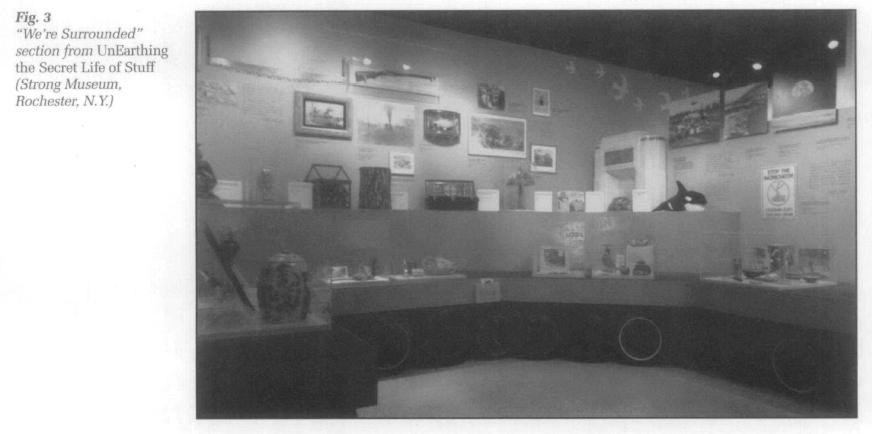 Display large image of Figure 3
Display large image of Figure 321 The opening section of UnEarthing the Secret Life of Stuff, called "We're Surrounded," presents an assortment of seventy-nine different objects and images, displayed under the headline "What do these objects tell us about people and nature?" The objects represent a range of American ideas about nature from around 1850 to the present day (Fig. 3). For example, a revolving glass fountain brought the delightful outdoor aesthetic of running water into a middle-class Victorian parlor. A ceramic "ABC" plate from the 1880s decorated with images of hunters clubbing seals taught children a lesson about harvesting natural resources. A turn-of-the-century glass terrarium offered the chance to subdue nature by enclosing it on four sides. For those who could afford a bit of luxury during the 1920s, a fine china and silver picnic set offered the prospect of getting close to nature — in a civilized way, of course. The striking, colorful image of Niagara Falls on a box of Shredded Wheat cereal from 1939 still bears witness to nature's power as a stimulus to consumer demand. A metal insecticide sprayer from the 1950s recalls the confidence with which we once ruled over the world of bugs and pests in our backyards and gardens. John Denver's smiling face captured amid the Rocky Mountains on the cover of his 1972 album, "Rocky Mountain High," encourages us to yearn for the great outdoors. And one of the most common fixtures found in American yards in the 1990s, a bird feeder, reflects our often contradictory tendency to support and appreciate nature on the one hand while subtly (and perhaps unconsciously) controlling it on the other.
22 The constellation of objects in this section of the exhibit would not come together under any other circumstances, and may appear at first glance as a mismatched jumble of nonsequiturs. But understood as a thumbnail history, in three dimensions, of changing American attitudes toward nature, this object group takes on remarkable explanatory efficacy. Moreover, it invites visitors to think about the "natural" meaning of countless other everyday objects.
23 This opening exhibit strategy dramatizes the connections between objects and the ideas about nature that they often convey. But even though the object meanings we suggest present the objects in a new and often unexpected light, this section nevertheless places the museum in the traditional position of authoritative narrator. We want individuals to play an active role in determining the ideas that objects convey. The message about nature that any object communicates is finally the result of negotiation between the object, the individual, and the cultural context in which they meet. We acknowledge this fact in the exhibit by routinely posing open-ended questions as an alternative to the authoritative voice of exhibit labels. We take yet another approach in a companion section called "You Choose the Label." Here we explicitly discount the museum's exclusive authority to determine object meaning by inviting visitors to choose from four alternative labels for each of half a dozen objects: a nineteenth-century mousetrap, a 1920s fur cape made from chipmunk pelts, a chain saw, a smoked sausage, a polyester jump-suit, and the electric hand dryer from a public rest room.
24 The objects in "You Choose the Label" occupy a large wall space. On a big-screen TV monitor at the center of the space, images of the six objects appear next to brief, one-sentence labels that suggest the meaning of each object (Fig. 4). Using an adjacent computer trackball and monitor, each visitor can survey four alternative labels for each object, and select the one that most closely matches his or her own concept of its meaning. The selection remains on the main screen display until a subsequent visitor makes a different selection. The user can also call up a simple bar graph to see how his or her label choice compares to an ongoing tabulation of choices made by other visitors.
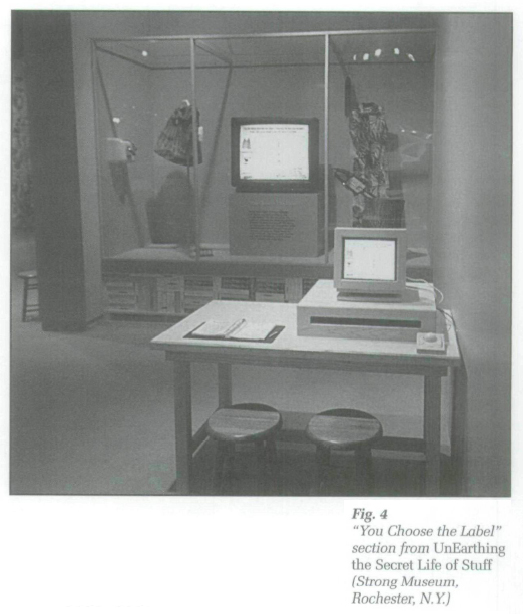 Display large image of Figure 4
Display large image of Figure 425 One of the challenges in creating multiple alternative object labels is to craft the choices in a way that they are all plausible. We attempted to move from left to right on the environmental spectrum, as these two examples illustrate:
26 The freedom offered the visitor in this case is limited and imperfect because the museum has outlined the range of options from which the visitor may choose. But as a method of suggesting that museum visitors have a role to play in determining object meaning, this section places the visitor in an unusual and intriguing position that evokes engagement, interest, discussion, and high rates of participation among both young people and adults. The broad distribution of responses recorded suggests that we achieved our goal of making multiple meanings plausible.19
27 The second half of UnEarthing the Secret Life of Stuff examines the life cycles of everyday objects and the environmental consequences of creating, using, and disposing of them. Analyzing the environmental relationships that objects embody offers the prospect of reuniting objects with their environmental histories, thus reintroducing the connection between production and consumption and illuminating their combined environmental consequences. This level of material culture analysis also introduces other important advantages to the study of environmental history because the critical analysis of an object immediately focusses historical discussion on one specific set of circumstances: social, ecological, productive, and ideological.20
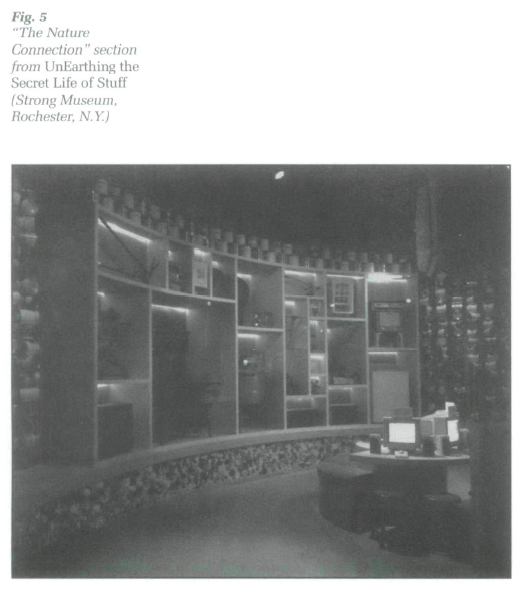 Display large image of Figure 5
Display large image of Figure 528 This part of the exhibit uses a number of complementary approaches to explore the environmental relationships that objects embody. In one area, we offer one-minute, multiple-screen video histories of the life cycles of three everyday objects: an aluminum can, a pencil, and a bar of soap. The complex connections between even these mundane objects and the environment suggest that the environmental implications of every object ought to be taken seriously.
29 Another related section explores the unintended environmental consequences that arise from object creation, use, or disposal. For example, improvements in sanitation and medical technology — like the invention of carbolic acid, or heart pacemakers — have dramatically increased our life expectancy. But living longer also increases each individual's aggregate demands on the environment. Central heating made our homes more comfortable but increased home energy consumption many-fold. Fast food restaurants offer cheap, reliable meals, but consume extra energy keeping food warm, use up huge quantities of disposable packaging, and encourage the consumption of grain-fed meats. Once again, visitors can discover that simple objects embody profound environmental consequences.
30 In an adjoining section called "The Nature Connection," we compare in detail the life cycles of twenty-one objects representing one of three different time periods: the 1850s, the 1920s, and the 1990s (Fig. 5). Each object shown here met a basic need: preserving food, amusing ourselves, keeping cool, doing the wash, and the like. An interactive computer database, arranged in a user-friendly format, encourages visitors to explore the life cycles of these objects, and especially to compare the changing environmental implications of meeting these everyday needs from one period to the next. Graphics, text, and sounds offer an overview of life cycle information for each object.21
31 One object group shown in "The Nature Connection" represents our changing material response to the challenge of washing clothes. In the mid 1800s, doing the wash required a wooden washtub (Fig. 6). By the 1920s, middle-class Americans lucky enough to have electricity could employ the services of a wringer washer with a large copper tub (Fig. 7). Today, the automatic washing machine is a fixture in a sizeable majority of American homes (Fig. 8).
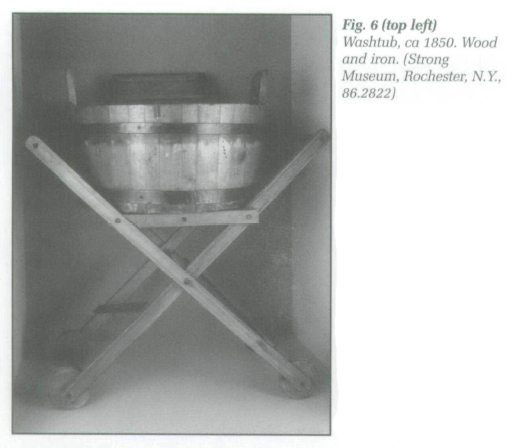 Display large image of Figure 6
Display large image of Figure 6 Display large image of Figure 7
Display large image of Figure 7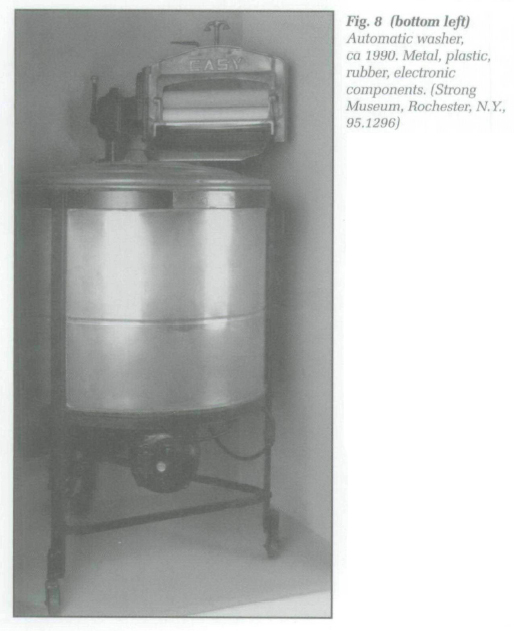 Display large image of Figure 8
Display large image of Figure 832 Typically, a museum exhibit presenting these three objects in sequence might tell one of two stories. The first is a simple story of material progress. Indeed, our present-day bias in favor of commodity-intensive convenience is so strong that simply juxtaposing the three objects triggers a subconscious narrative of improvement over time. The second story is an equally simple tale of environmental declension — beginning with a locally produced object made of "natural" materials, ending with the product of energy- and material-intensive industrial production.
33 Analyzed from the point of view of object life cycles, however, these three objects have quite a different, more complex, more nuanced, and finally more ambiguous story to tell. Each one embodies an extensive set of historically specific relationships and behaviors that have social, cultural, and environmental consequences. This broad web of connections reveals the often hidden connections between our everyday lives and the environment.
34 Today most of us wash clothes as part of our routine lives at home. Do we actively consider the environmental consequences of using an automatic washer? Probably not, beyond a quick glance at the reassuring "environmentally friendly" message on the detergent container. What have we overlooked? Here's a partial list:
- Washing machines use lots of water. Large-capacity machines can consume as much as forty gallons per load. Thus a family that does ten loads per week might generate upwards of four hundred gallons of waste water that must be treated before being returned to the environment. Of course, we know that domestic water consumption accounts for only a small fraction of the nation's water use, but providing water for the nation's homes requires a considerable investment of economic as well as natural resources.
- Washing machines require electric power to run. Turning on the washer ties the user to the environmental costs of generating that power: acid rain, air pollution, nuclear waste disposal, and so forth.
- It takes energy to heat the wash water. This involves more connections to generating electricity, or to the environmental consequences of exploration and drilling, and refining and delivering natural gas.
- Clothes don't come clean without detergent. Processing and distributing the detergent with the environmentally friendly message on the box exacts its own environmental costs.
This list describes only some of the environmental connections embodied in one part of the life cycle of a single object in our present-day material world. Thinking historically about the same part of the life cycle — use — this time for the 1920s washer, we discover the following:
- The 1920s washer also required water — although much less. Wash water might be changed once or twice during the wash day, instead of after every load. Often, the dirty water sometimes landed on the ground outside. If the water went down the drain, however, the chances are good that it flowed untreated into a nearby waterway.
- The 1920s washer also required electricity — although, again, less than the contemporary washer. But what was the environmental cost per unit of generating that power in 1920 as compared to today?
- It still took energy to heat the water. The most likely sources of energy: coal or gas, both of which connect the user to the environmental consequences of mining, processing, transporting, and burning the fuel.
- 1920s households having the wherewithal to purchase and operate an electric washer probably consumed commercially produced soap flakes. Soap flakes tied the user to the environmental consequences of meat packing, rendering, and industrial production and distribution of soap.
This list begins to suggest the complexity of environmental life cycle comparisons from one moment in time to another. It also suggests that simple judgements about which object is "better" or "worse" for the environment begin to break down rather quickly when we explore the interlocking web of environmental relationships that each object embodies.
35 A consideration of the wooden washtub from the 1850s adds further complexity to this comparison:
- Using the tub required water, but far less man the later washers. This is fortunate, as transporting water from the well, the pump, or the river was a major chore. When the wash was done, the person using the tub dumped the dirty water over the porch rail or on the ground nearby.
- Washing clothes in a tub required energy in the form of calories, but had no direct impact on the condition of the atmosphere.
- Energy to heat water for the tub came from wood burned in a stove, or outdoors over a fire (on hot summer days, for example). In 1850, as in 1990, heating water consumed resources and had consequences for the atmosphere.
- Many American households still made their own soap in the 1850s, using locally produced lye and potash. Was this early form of recycling a net plus for the environment? Surely it did not impose the same magnitude of environmental cost as the commercial production of soap. But what about burning wood to produce the potash?
These comparisons cover only one part of the life cycle — use — for these three objects. Critical reflection on this information leads us away from both the progress and the declension narratives, and points instead to a highly specific and very revealing web of changing historical relationships to the environment through our material culture.
36 Exploring the remainder of the life cycle shows that there's yet much more to the story. Creating these objects connected people to the environment in other complex ways. Wood and iron fittings for the washtub, as well as the charcoal required to shape the iron, came from local and regional sources. Making the tub left a relatively benign residue of wood shavings and iron filings. The process for making a copper washer in the 1920s, however, involved a far more complex set of environmental connections. Iron, copper, and brass required mining, refining, and smelting on their way to the washer factory. Rubber-making depended on latex harvested from Asian rubber trees. Producing the washer consumed energy and water and created waste products and runoffs that found their way into the environment.
37 Making an automatic washer today involves a similarly intensive industrial process. But a different array of materials — steel, plastic, synthetic rubber, and various electronic components — creates yet another unique set of environmental connections. Because the materials are likely to be created further from the point of assembly than they were in the 1920s, an even broader web of environmental connections is involved. Industrial production continues to consume water and energy, and to generate a variety of waste products. However, the ultimate impact on the environment may be less severe than in the 1920s because today many wastes are treated before they return to the environment.
38 And what about disposal of these objects when they wore out or became obsolete? The washtub could be broken up for kindling, filled with something solid, or tossed out back to rot. Not so easy with a wringer washer! A junk dealer might have found the machine's copper and brass worth saving. Otherwise, it might have ended up in a dump or in the basement. Since the 1920s, the problem of what to do with worn-out appliances has grown more serious. A typical family might go through three or four washing machines during their lives together. Recent EPA figures show that junked appliances and other formerly "durable" goods take up nearly a quarter of the space in our landfills.22
39 Why don't we think more consciously about these connections to the environment through our material lives? In addition to the reasons cited above, our culture does not organize its knowledge about objects in this way. Consult a standard reference source on the subject of producing washing machines, automobiles, televisions, toasters, clothing, glassware, paper, video cassettes, or any of the thousands of other objects we use every day. You will find lots of information on manufacturing techniques, sales figures, and the like, but nothing about where the materials come from, what the environmental implications of manufacturing are, or what sorts of problems we encounter in throwing them all away when they no longer serve our needs. And we can be certain that the producers of all of these objects — for reasons that are quite understandable — are unlikely to want to spend their time bringing this information to our attention.
40 The systematic examination of object life cycles has the potential to illuminate — through the stuff of our everyday lives as consumers — frequendy overlooked connections between our behavior and environmental consequences. Tracing and comparing object histories can also communicate in powerful ways both the magnitude and the complexity of the environmental transformations that have taken place in our nation's brief history.23 But these are only the beginning steps in our material exploration of the rich new field of environmental history. Many additional levels of complexity in the material culture of environmental history remain to be explored.
What Next?
41 For reasons related to the Strong Museum's mission and collections, we chose to focus our examination of environmental history on the national political economy of production and consumption. But the critical element of place — of regional differences and of geographic variation in our relationship to the environment — could easily emerge from the examination of a similar set of objects. How many county, state, or regional history exhibits have we seen that begin with a brief discussion of the area's natural history and geography, only to abandon that thread as soon as people appear in the story? Imagine how such an exhibit might look if it concentrated more fundamentally on the changing relationship between the people in that place and their surroundings throughout the entire history it represents.
42 Yet another application of the tools of material culture analysis to environmental history involves searching out the meaning of human "artifacts" in nature. How can we most effectively explore the changing meaning of landscapes, of wilderness areas, of rivers and watersheds, and of national parks as they are shaped and reshaped by human actions?24 The challenge of bringing these "artifacts" inside the museum gallery proved insurmountable for the UnEarthing exhibit project, but could well succeed in the context of a different museum space, or perhaps in a suitable outdoor presentation.
43 Finally, and perhaps most fundamentally of all for the long-term viability of this approach to the study of environmental history, we will need to develop ways to compensate for the bias of material culture toward individual behavior rather than society's behavior as a whole. Individual choices help shape our relationship to the environment, but so surely do collective decisions about resource use, environmental protection, and other issues of public policy. Using material culture to interpret environmental history treads a narrow path between suggesting that the proper changes in our individual behavior could solve most of the environmental "problems" that we face at the end of the twentieth century, and the opposing argument that individual responses to environmental challenges are futile because the problems we face are national or global in scale and arise not from individual decisions, but from greed, ignorance, corruption, or apathy on the part of governments and big corporations.
44 One good place to pursue these further explorations of environmental history is in museums because, at their best, they constitute a public forum for critical discussion of contemporary social and political issues framed around the historical interpretation of material culture. But museum exhibitions are not the only arena in which the connections between environmental history and material culture need to receive critical scrutiny. The approach to material culture outlined here has the potential to create dialogue and build bridges across the lines that separate public and academic scholarship. Critical inquiry on the part of scholars both in and out of the academy could be brought to bear on these issues of practical concern to the general public.25 The broadest possible engagement among all the practitioners of environmental history would be a suitable complement to the field's emerging profile as an inclusive, cross-disciplinary, synthetic approach to the study of humanity's ongoing relationship to the world it both shapes and inhabits.
Chain Saw 1; 25% 2:15% 3:24% 4:36%